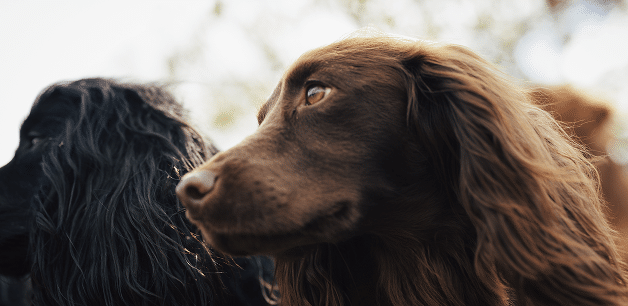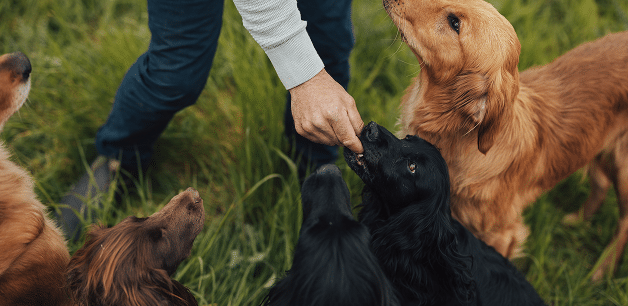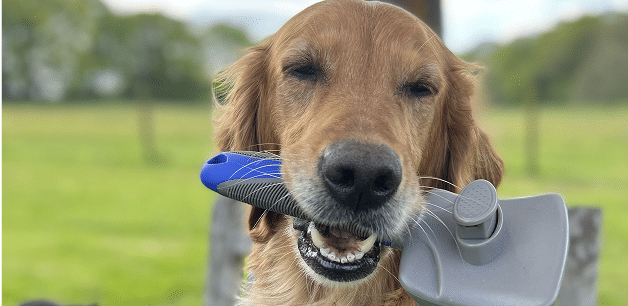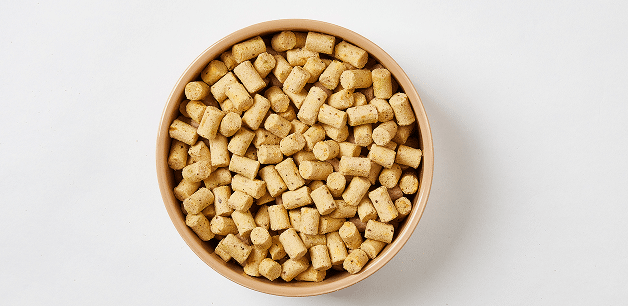Is your dog struggling with spring allergies?
Spring is one of my favourite times of the year – longer days, blooming flowers and plenty of outdoor adventures with my dogs. But for some, it also brings endless scratching, irritated skin and frustrating allergies.
If you’ve noticed your dog struggling with itchy skin or ear infections this season, their diet could be a key factor. Choosing the right hypoallergenic dog food can make a world of difference.

Signs your dog may have allergies
Allergies in dogs can manifest in a variety of ways, especially in spring. This often makes it tricky to pinpoint the exact cause. If your dog is struggling with food sensitivities or environmental allergens, you may notice:
Excessive scratching – Constant itching, particularly around the face, ears, and paws can signify skin problems.
Licking or chewing paws – A telltale sign of irritation, often linked to food allergies.
Recurring ear infections – Frequent head shaking, redness and an unpleasant odour in the ears.
Inconsistent poos – Diarrhoea, soft stools or an upset stomach could indicate a reaction to their diet or environment.
Watery eyes and sneezing – Similar to hay fever in humans, allergies can cause irritation around the eyes and nose.
Red or inflamed skin – Bald patches, rashes or hot spots often develop due to excessive scratching.
Frequent tummy troubles – Vomiting, bloating or excessive gas may signal a food intolerance.
If you have a sensitive dog who is showing any of these symptoms consistently, it’s important to understand why in order to make an informed decision on how to manage it.

What causes food allergies in dogs?
Food allergies occur when a dog’s immune system mistakenly identifies a particular ingredient as harmful, which then triggers an allergic reaction. This immune response can lead to a range of uncomfortable symptoms, from itchy skin and digestive issues to chronic ear infections and even behavioural changes. Springtime brings a range of environmental irritants too such as dust and pollen, which can exacerbate any food allergy symptoms already present in your dog.
Some of the most common culprits in dog food for allergies include:
Wheat and grains – While not all dogs are sensitive to grains, those with allergies may struggle to digest ingredients like wheat, corn and grains, leading to skin irritation and digestive upset.
Dairy – Many dogs are lactose intolerant, meaning their bodies can’t properly break down dairy products, causing bloating, diarrhoea and stomach discomfort.
Certain proteins – Some dogs can be allergic to certain proteins. If your dog is showing signs of a food allergy, your vet should be able to help you narrow down which ones to avoid through allergy testing.
Identifying the right diet for your dog can be hugely helpful in managing their allergies. By eliminating common allergens and opting for a hypoallergenic diet for dogs, you can help support their overall health and wellbeing.
I’ve seen first-hand how frustrating it can be when a dog is constantly uncomfortable. That’s why I’m so passionate about ensuring every dog gets the best possible diet – one that’s free from unnecessary fillers and potential allergens.
How hypoallergenic dog food can help
Switching to a hypoallergenic diet for dogs means removing common allergens and replacing them with more highly digestible, limited-ingredient alternatives. These diets often use single proteins or novel protein sources which are easier for dogs to tolerate.
You might also find some veterinary diets using hydrolysed proteins to help with allergy management. However these diets often contain poor quality ingredients, so always remember to read the label first in order to make an informed decision for your dog.

Finding the right hypoallergenic food for your dog
Not all anti allergy dog foods are the same. If your dog is struggling with food sensitivities, here’s what to look for when choosing the best dog food for food allergies:
Limited ingredients – The fewer ingredients, the fewer chances of an allergic reaction.
Novel proteins – If your dog has a protein allergy, look for proteins like venison, duck, or fish as they are nice and easy to digest.
No artificial additives – Avoid artificial preservatives, colours and flavourings that may trigger allergies.
Highly digestible carbohydrate sources – Ingredients like sweet potatoes and beetroot are much healthier alternatives to grains.
Balanced nutrition – A complete and specially formulated diet that supports overall health, not just allergy relief.
At James & Ella, we believe in feeding dogs the best, which is why our hypoallergenic dog food options – including Freeze-Dried Raw, Kibble + Raw and Cold-Pressed – are designed to be gentle on digestion while providing all the essential nutrients dogs need to thrive.
Here are some of the benefits of James & Ella’s hypoallergenic dry dog food range:
Skin and coat health – Rich in omega-3 and 6 fatty acids, helping to reduce skin irritation and promotes a shiny, healthy coat.
Easily digestible – Made with high-quality, easily digestible ingredients, supporting a healthy gut and reducing gastrointestinal issues.
Grain-free – Ideal for dogs with grain sensitivities, providing a balanced diet without common allergens.
Hypoallergenic ingredients – Carefully selected ingredients to minimise the risk of allergic reactions, including single proteins and limited ingredients.
Promotes immune health – Packed with essential vitamins and minerals to strengthen your dog’s immune system.
Free from artificial additives – No fillers, preservatives, or artificial colourings ensuring a natural and nutritious diet.
Great for picky eaters – Highly palatable recipes, James & Ella diets are a hit with even the fussiest of dogs.
If you’re ready to find the right hypoallergenic dog food for your dog, explore our full range here. If you have a puppy with signs of food allergies or you’re planning on welcoming a new puppy into your home, starting them on a hypoallergenic puppy food such as our Kibble + Raw for Puppies can help prevent future allergy or sensitivity issues.

Other ways to help your dog’s allergies
While diet plays a huge role, there are additional steps you can take to help reduce allergy symptoms:
Regular grooming – Brushing helps remove allergens trapped in the coat – I use a Tangle Teezer brush on my Cocker spaniels and Golden Retrievers!
Hypoallergenic shampoo – Can soothe itchy skin and help wash away environmental irritants.
Cleaning bedding and toys – Reduces exposure to dust mites and pollen.
Monitoring treats – Make sure any treats are hypoallergenic to align with their diet. Our Air-dried and Freeze-dried treats are ideal options.

Choosing the best dog food for allergies
If your dog is constantly itching, switching to the right dog food for itchy skin can provide real relief for your dog.
At James & Ella, we know that nutrition is at the heart of a dog’s well-being. That’s why we’ve carefully created a range of hypoallergenic food, using high-quality proteins, natural ingredients and no unnecessary fillers. Our range of dog food for dogs with skin allergies and dog food for sensitive skin is designed to help dogs feel their best – no matter the season.If you’re unsure which diet is best for your dog, our in-house nutritionist, Lauren is always happy to help. If you need support with your dog’s diet, feel free to book a free Nutrition call!
Until next time,
James x
